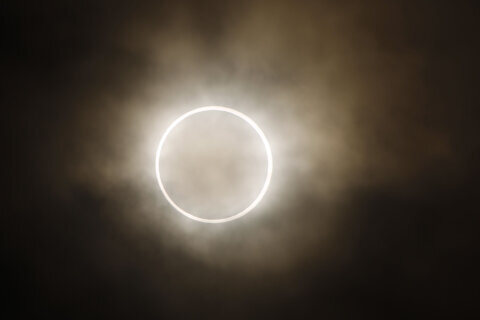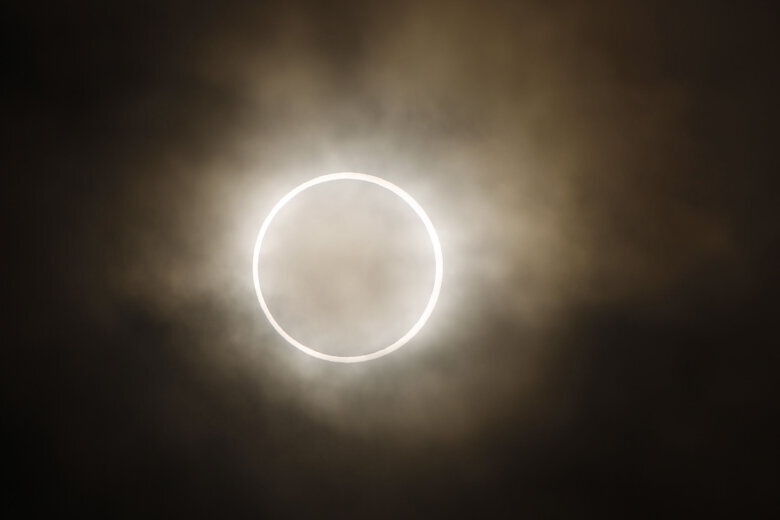
The new moon and the sun will meet Saturday, Oct. 14, in the skies over North America to create a “Ring of Fire” annular solar eclipse for some, a partial solar eclipse for others, and a day to watch online for millions more who are not in the path of the Moon’s shadow or are clouded out.
The last solar eclipse for the D.C. region was a partial solar eclipse at sunrise in 2021.
If you want to view the sun directly during this solar eclipse, you MUST do so safely using the following guidance. Parents, if your children are participating in viewing, please exercise due caution to ensure they do so safely.
As stated by the American Astronomical Society (AAS): “Since there will still be plenty of the sun’s bright face showing, it is absolutely essential throughout the entire eclipse to view through a safe solar filter, that is, one that meets the transmission requirements of the ISO 12312-2 international standard. Such filters are widely available and cost at most a few dollars.
“Looking at the uneclipsed or partially (or annularly) eclipsed dun through dark sunglasses or any other unapproved filter is a recipe for serious and potentially permanent eye injury. See our Eye Safety and Resources pages for details.”
You can also use the Pinhole Projection method to safely observe the eclipse. As stated by the AAS: “Note that pinhole projection does not mean looking at the sun through a pinhole! With the sun at your back, you project sunlight through the hole(s) onto a surface and look at the solar image(s) on the surface.”
If you do not have an ISO 12312-2 standard safe solar filter or if it is cloudy, you can watch the eclipse live from a number of online venues.
The D.C. area will also be hosting the following in-person events:
D.C.
- Rock Creek Park’s Planetarium “Eclipse: The Sun Revealed” 30-minute film
- Smithsonian’s National Air and Space Museum event
Maryland
- Astronomical Society of Greenbelt at the Greenbelt Observatory
- Annular Eclipse Event 2023 at William Brish Planetarium
- Gaithersburg Community Museum
Virginia
- Smithsonian’s Udvar-Hazy Center
- George Mason University Observatory
- Richmond Astronomical Society at the Science Museum of Virginia
- Fairfax County Park Authority has three events at the following locations:
- Burke Lake Park
- Turner Farm Park Observatory
- Sully Historic Site
Scientists will be geared up for this eclipse as well as the Total Solar Eclipse in the U.S. on April 8, 2024. NASA expects that science efforts will also include citizen scientists.
“The eclipse also provides a unique opportunity for citizen science. GLOBE Observer and Eclipse Soundscapes allow citizen scientists to submit observations on sounds, temperature, cloud cover, and more to help scientists understand how eclipses can affect Earth’s atmosphere and animal life. NASA also has STEM learning resources tied to the eclipse,” the agency said.
I will be in Texas for both solar eclipses, and I hope to share my astropics with you as soon as I get them as I have done in the past, most recently being at sea in Australia for April’s Hybrid Total Solar Eclipse.
NASA has a brand-new online resource called the “2023 Eclipse Explorer: Your Interactive Guide to the 2023 Annular Solar Eclipse.” Eclipse Explorer can provide detailed eclipse information for your exact location.
For the D.C. region, the sun will be about 30% eclipsed with the following EDT timetable as shown in Eclipse Explorer:

For your smartphone, the American Astronomical Society (AAS) and Big Kid Science have “Released version 3.0 of the Totality app, available free for iOS and Android smartphones. Totality, your solar eclipse companion, puts recent and upcoming annular and total eclipses in your pocket.” You might want to also download the free NASA app, which will keep you up to speed on all things NASA including NASA TV.
You can try to image the eclipse, but you MUST follow solar safety procedures exactly as described. Failure to do so can injure your eyes and damage your camera.
So, sit back and be an armchair astronomer for the day. Enjoy the view of this grand celestial event however you can — safely. This will be good practice for our 2024 partial solar eclipse in the D.C. region, when the sun will be a whopping 87% eclipsed!
Follow me on X @SkyGuyinVA and my daily blog at What’s Up?: The Space Place to keep up with the latest news in astronomy and space exploration. You can email me at skyguyinva@gmail.com.








